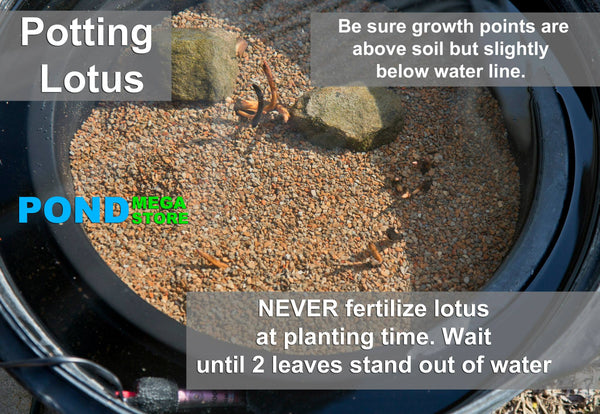Reserve Your Lotus Today
for the 2024 season!
Lotus are seasonal plants and can only be planted
in the spring unlike waterlilies and other pond plants.We will ship Lotus tubers with instructions about 2-3 weeks before your proper planting time to ensure a great season!
How to Properly Plant Sacred Lotus Flowers
Properly Planting Lotus Flowers
When planting lotus, plant from tubers, not seeds. Only tubers are identical copies of the parent hybrid varieties. (to learn about growing lotus from seed)
Tubers are dormant roots, similar to a potato, but more tender with a star shaped air chamber inside. Once a lotus tuber breaks dormancy, the roots grow into runners. You cannot disturb or break the root at this time, or you will likely kill the tuber. That is why we send lotus tubers from March through May.

You can keep lotus tubers in your refrigerator for a number of months if they have been cleaned and disinfected. This is how we ship lotus tubers to you. Clean, disinfected, bruise free and with 2-4 growth tips.
Planting Tips
DO PLANT YOUR LOTUS OUTDOORS, but do not plant lotus tubers outside too early (Mid May is preferable, after all danger of frost has passed)
It is best to plant your lotus tubers OUTDOORS. Only days after sprouting indoors, the plants may weaken.
Lotus tubers are best planted when nights are no lower than 45 degrees. (You can start them earlier, but the tubers will take much longer to grow if placed outside during cool nights.
Please Note: When planting tall/large lotus tubers as an edible vegetable, the growing instructions are different. Please follow this link to learn about that growing method.
Containers
The lotus container you choose is going to be the container for the whole year. Be certain it is wide enough for the variety chosen.
- Exquisite of Bowl & Dwarf Lotus need a wide, shallow container, 10-12" in diameter, with 1- 3" of water above the soil
- Dwarf Lotus should have a 14" wide container and again just about 3" of water over the growth tips.
- Medium Lotus need a wide, shallow container, 18" in diameter, with 2-5" of water above the soil
- Tall Lotus need a wide, shallow container, 18-24" wide or wider in diameter, with 3-7" of water above the soil
The size of containers listed above are the minimum for each size.
The larger your container, the taller your lotus will grow--and will produce more blooms!
The containers should be wide and shallow, not deep. The lotus containers are placed close to the surface of the water, not at the bottom of the pond.
The containers should be wide and shallow, not deep. The lotus containers are placed close to the surface of the water, not at the bottom of the pond.
We recommend round pots as they allow the roots of the tubers to run around the pot and not become root-bound.
Planting Medium
Use loam (a mix of topsoil and half calcined clay with little to no organic material), well composted manure can be used with topsoil, but you need to limit the initial nutrition or you will burn the plant.
1. Add a few inches of this mixture to your container.
2. Dig a trench and place the lotus tuber in the trench, being careful not to break the growth tips, while keeping the growth tips exposed.
3. You may use a small stone on top of the tuber to keep it from floating.
1. Add a few inches of this mixture to your container.
2. Dig a trench and place the lotus tuber in the trench, being careful not to break the growth tips, while keeping the growth tips exposed.
3. You may use a small stone on top of the tuber to keep it from floating.
4. Add the desired amount of water above the soil and place your lotus container in full sun.
In a couple of days, coin leaves will appear on the surface of the water. In a week you should have aerial leaves growing out of the water. Once you have aerial leaves, you may begin to fertilize your lotus.
(Instructions on how and when to begin fertilizing lotus)
We recommend 1/2 the recommended dosage of a slow release fertilizer the 1st time you fertilize. After that, follow the dosage instructions of your fertilizer and fertilize every three weeks during the growing/blooming season. Usually June through August.





Lotus with leaves above the surface and ready to fertilize with an initial half dose of fertilizer (2 to 4 tablets) in 10 days you can fertilize again, either a half dose if still small or full dose if the plant has tripled in size... start slow or you will stunt them for the whole season.
Here is a photo of a harvested pot the year after we planted just a single start. Now we can separate them and
Here is a photo of a harvested pot the year after we planted just a single start. Now we can separate them and
sell the larger, healthy tubers!

- Home
- Planting Lotus Tubers
- Fertilizing Lotus
- Favorite Lotus
- Lotus from Seed
- Overwintering Lotus
- About us
© 2025 PondLotus.com . All images and videos copyright PondLotus.com



